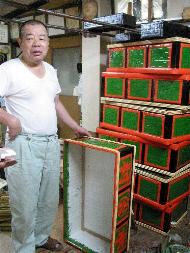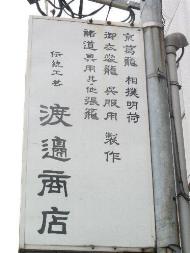|


| Attention to Akeni
|

|
Carolyn Todd
SFM's newest addition to the writing staff takes an
in-depth look at akeni, their history and production techniques
|
|
| Rikishi of Old
|

|
Joe Kuroda
Joe Kuroda slides former yokozuna Minanogawa under his SFM microscope |
|
| Eric Evaluates
|

|
Eric Blair
Eric's wit scythes through the SML and makes clear his opinion of where the future lies for online sumo forums. |
|
Eternal Banzuke Phase II
|

|
Lon Howard
Stats, equations and mathematics all lead to a list of sumo's most prolific up and downers
|
|
|
|
|
Heya Peek
|

|
Mark Buckton
Mihogaseki, former home of Estonian sekitori Baruto is toured (and peeked at) by SFM's Editor-in-Chief
|
|
|
|
|
|
|
Nagoya Basho Summary
|

|
Lon Howard
Lon gives us his Nagoya basho summary, along with the henka sightings results
|
|
|
Lower Division Rikishi
|

|
Mikko Mattila
Mikko Mattila casts his watchful eye over lower division goings on in makushita and below.
|
|
|
Aki Ones to Watch
|

|
Carolyn Todd
Carolyn takes over the job of rikishi job performance prediction for SFM as she looks at those to keep an eye on come September |
|
|
Kimarite Focus
|


|
Mikko Mattila
Our man Mikko's latest trio of kimarite get thrown about the SFM literary dohyo |
|
|
Amateur Angles
|


|
Howard Gilbert
Howard returns with the second of his columns on the amateur sumo scene.
|
|
|
Sumo Game
|

|
| SFM's very own quiz comes in for a bit of self scrutiny by our secretive man of questions. We'll call him 'X'. |
|
|
Sumo in Print
|

|
Barbara Ann Klein
SFM’s Editor reviews “The Little Yokozuna”, a book for “young” (and older) adults
|
|
| Kokugi Connections
|

|
Todd Lambert
Check out Todd's bimonthly focus on 3 of the WWW's best sumo sites
|
|
Fan Debate
|
 
|
Facilitator - Lon Howard
Keri Sibley and Eduardo de Paz ponder the concept of ‘to pay or not to pay’ makushita salaries
|
|
SFM Cartoons
|  |
Stephen Thompson
Sit back and enjoy the offerings of one of sumo's premier artists |
|
Lets Hear From You
|
 
|
| What was it that made you a sumo fan? SFM’s own Todd Lambert details his path into sumofandom
|
|
|
|
| Sumo Quiz |
The Quizmaster
Answer the Qs and win yourself next basho’s banzuke. |
|
|
|
 |
|
Mr. Watanabe with his akeni
mawashi of Akebono, Takanohana, and others. One akeni holds one kesho
mawashi, which are presented in sets of three to yokozuna, so each
order requires three akeni with the name of the sponsor painted on the
side. Twenty companies asked him to make boxes for Takanohana at the
same time so 60 akeni had to be made. When Takanohana
became yokozuna, he had over 100 akeni. Unfortunately, even though
his career lasted over eight years, the yokozuna couldn’t
wear all of his kesho mawashi before he retired, which surely horrified
the unlucky sponsors, considering the combined cost of kesho mawashi
and akeni.
Mr. W’s skills are requested by several unusual
clients. As he is the only tsuzura maker in Japan, he was asked  |

|

|

|
to make
kimono boxes to be sent to Hollywood for the movie “Sayuri” (known as
“Memoirs of a Geisha”, internationally), which was set in pre-WWII days. He
also makes kimono boxes for maiko and geiko, and costume boxes for
kabuki actors. His smaller letter boxes are used by gyoji to store
gunbai.
Mr. W is unusual for his generation, especially in Japan - a maverick
who virtually created his own industry and whose hard-earned skills are
in global demand. His enthusiasm for his work is infectious, and to see
him running around, showing off photos and pulling out dusty antique
boxes, made me happy that this sumo tradition is safe with a family who
value the old techniques, as well as their own techniques, and protect
them so carefully. It’s hard to believe that Mr. W contemplated
retiring a decade ago as he seems so content. His explanation is that
craftsmen work until they die. It seems dramatic, but as long as Mr. W
can slice bamboo, he’ll continue to produce these beautiful, but
eminently functional, works of art.
A variety of boxes can be made to order, including woven letter
trays/boxes, black-lacquered kimono-type boxes or the traditional
green/red akeni, complete with shikona. The box sizes are fixed and a
regular-sized akeni runs 100,000 yen. There are miniature ones,
one-eighth of the regulation size, decorated the same. It’s
ridiculously cute, although obviously in a strong
|
|

|

|
wrestler-type way,
and costs 60,000 yen. The letter boxes start from 14,000 (B5), 15,
000 (A4), and 16,000 yen (B4). If you want to take a further look at
the range and the process, check out the webpage below. And if you
happen to be in Kyoto and want to visit the workshop yourself, you can
make an appointment by phone/fax (in Japanese). You are now
invited to view the Akeni Photo Bonanza.
W SHOTEN
Gojo-kudaru Higashi-hairu Higashi-Oji,
Higashiyama-ku, Kyoto 605-0871
Phone/Fax: +81-75-551-0044
Web-site
Home |

|






